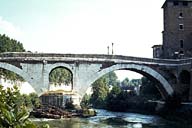
|
Image-GoddenB2
Romans were pioneers in the use of arches for bridges, buildings, and aqueducts. This bridge, the Ponte Fabricio in Rome, spans between the bank of the River Tiber and Tiber Island. Built in 64 B.C. (Rome, Italy.)
|
|
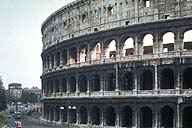
|
Image-GoddenB3
Colosseum, originally known as the Flavian amphitheater. Conceived by Emperor Vespasian and completed in the reign of Domitian (AD 81-96). The Colosseum seated 50,000, and its plan dimensions are 620 ft X 513 ft. (Rome, Italy.)
|
|
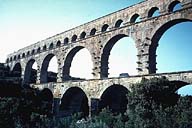
|
Image-GoddenB4
Pont-du-Gard. Roman aqueduct built in 19 B.C. to carry water across the Gardon Valley to Nimes. Spans of the first and second level arches are 53-80 feet. (Near Remoulins, France)
|
|
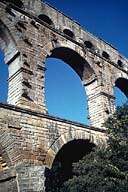
|
Image-GoddenB5
Roman aqueduct built in 19 B.C. to carry water across the Gardon Valley to Nimes. Note the scale indicated by figure at base of second level column.The projecting blocks in the middle pier were used to support wooden scaffolding and falsework for the voussoir arch stones. (Near Remoulins, France)
|
|
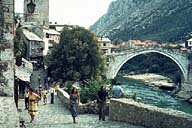
|
Image-GoddenB6
The 'Stari Most' (Old Bridge) was built in 1566 and spans the Neretva River. Fine example of early Turkish bridge construction. The arch has a span of 27.3 meters and a rise of 19 meters above the river. (Mostar, Bosnia and Hercegovina (former Yugoslavia))
|
|
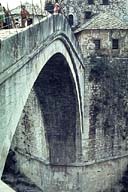
|
Image-GoddenB7
End view of 'Stari Most' (Old Bridge), built in 1566. It is recorded that the first time the falsework was removed, the arch collapsed. The Sultan ordered the architect to be executed if he was not successful on the second attempt. The architect fled before the supporting timber was removed, but the bridge stood for over 400 years. (Mostar, Bosnia and Hercegovina (former Yugoslavia))
|
|
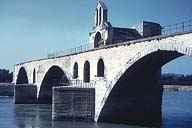
|
Image-GoddenB8
Pont d'Avignon. Built 1177-1187 across Rhone River by Benezet and the Freres Pontiffes. There were originally more than 20 spans of which only four with chapel now remain. Spans vary in length from 101 to 110 feet. Elliptical arches with long axis vertical. Considered the most famous of the medieval chapel bridges. (Avignon, France)
|
|
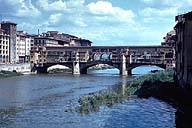
|
Image-GoddenB9
Ponte Vecchio, Italy. Italian Renaissance bridge built 1340. Its most important feature is its segmental arches (segment of circle less than a semi-circle), and first built in the West. This design required fewer piers, and hence caused less obstruction to navigation than semi-circular Roman bridges. (Florence, Italy)
|
|
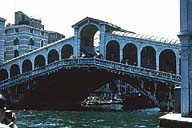
|
Image-GoddenB10
Rialto Bridge. Another example of Renaissance bridge design, spanning Grand Canal. For many years the only bridge joining the two halves of the city. Built in 1587 it replaced a timber bridge which collapsed when a crowd used it to watch a ceremony on the canal. Result of a design competition. (Venice, Italy)
|
|
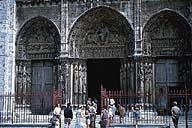
|
Image-GoddenB11
Notre-Dame Cathedral. Fine example of Gothic architecture, built in mid-13th century. Ornate west entrance shows the use of arches in early building construction. (Chartres, France)
|
|
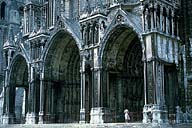
|
Image-GoddenB12
Notre-Dame Cathedral. South entrance. Note the use of heavy ornate pinnacles to increase the stability of the piers against overturning from horizontal thrust component of the arch. (Chartres, France)
|
|
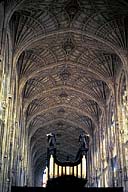
|
Image-GoddenB13
King's College Chapel. One of the finest examples of medieval architecture in England. Built in 1446-1515, Fan vaulting in the ceiling is essentially a series of pointed arches that require external buttresses to react to the horizontal thrust. An external view of this building showing the buttresses is given in Godden Set F. (Cambridge, England)
|
|













